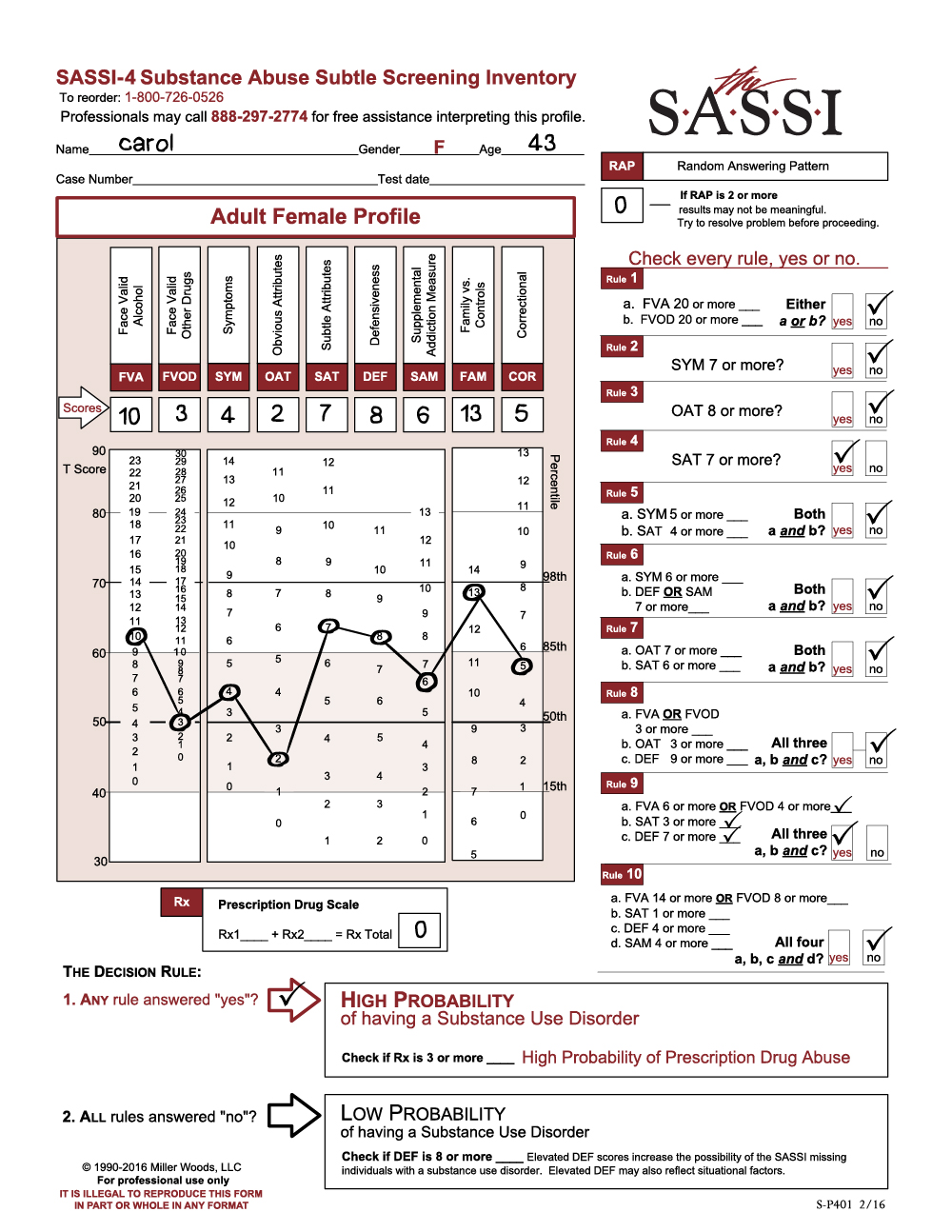The client, Carol, is a 43-year-old married female, a successful business woman and mother of two children. She recently was arrested and charged with her first DWI after leaving a business dinner with sales associates. This is the first significant consequence related to her drinking. She claims that she does not have a drinking problem; however, she characterizes her mother as an alcoholic.
As we take a look at her scores, first notice that Carol appears to have responded in a meaningful way to the items on the SASSI-4 (RAP=0). However, there is some evidence that she may have approached the assessment process in a defensive manner (DEF=8). Despite her apparent defensiveness, the SASSI results indicate that she has a high probability of having a moderate to severe substance use disorder (SAT=7 leading to a positive on decision rule 4).
Given the elevations on the SAT and DEF, we get the sense that Carol may have some difficulty recognizing (high SAT) and acknowledging (high DEF) the nature of her substance-related problems. Yes, it is true that she reports significant problematic use of alcohol (FVA=10). However, it will be important to review with her the content of her responses on the face valid alcohol scale in order to gain some understanding of how she views these consequences. Our experience with the SASSI and our knowledge of the nature of the addictive process suggest to us that individuals who have elevated SAT and DEF scores (especially when OAT is average or below, as is the case here) often have difficulty seeing the manner in which their drinking has pervaded other areas of functioning. Therefore, it is reasonable to expect that much of what she has reported on the FVA may be flavored with a theme of, “I’m so embarrassed about these things, but thank God I don’t have a problem.”
Carol’s FAM score is elevated (13), suggesting that her responses are similar to individuals who have a history of being in relationships with others who are substance dependent. This is often related to a tendency to focus on others and a need to try to control the external environment. Elevated scores on SAT, DEF, and FAM suggest that Carol is likely to have an exceptionally strong tendency to deflect attention away from any suggestion that it is important for her to make significant changes in her life. Carol’s lack of awareness and insight may not only be rooted in her own addictive disorder but may also be fostered by a long history of trying to cover up for her mother and feeling responsible for the family’s welfare.

Despite Carol’s inability to see her substance misuse as a serious problem in her life, the SASSI results clearly indicate that she is likely to meet the diagnostic criteria of a substance use disorder. Therefore, effective treatment planning will need to include some form of addictions therapy, most likely at the outpatient level of care. The therapeutic challenge for the treatment provider will be to establish a working relationship with Carol that is conducive to helping her explore the substance abuse issues in her life. This usually means starting where the client is and moving her in a direction of increased awareness and insight regarding the nature of her own substance use problems and the changes that can help her begin a process of healing and recovery.
Carol comes to the treatment setting with recognition of her mother’s alcoholism. She has a desire to disclose information about her life growing up with an alcoholic mom. This gives the treatment provider a naturally occurring place to begin. As Carol bonds with her therapist in the work of resolving the pain of her childhood, the therapist can help her examine the significance of her own alcohol usage. The therapy can be augmented by support groups in which Carol can learn from the experiences of others who come from similar home environments and from other people who have had to struggle with the reality of their own addiction problems. Ongoing assessment will be helpful during this process to monitor her progress and make adjustments in the treatment plan as necessary. For example, if she is unable to refrain from using, has additional alcohol-related social or legal consequences, or becomes non-compliant in the treatment process, it may be necessary to move to a more intensive level of care.
The emotional impact of growing up in an environment that is dominated by the pain and shame of addiction takes many forms and can exert its influence throughout a person’s life. Carol’s DWI can be a gift. With appropriate intervention, Carol can begin a process of self-examination and growth that will lead to a freer, richer life.
